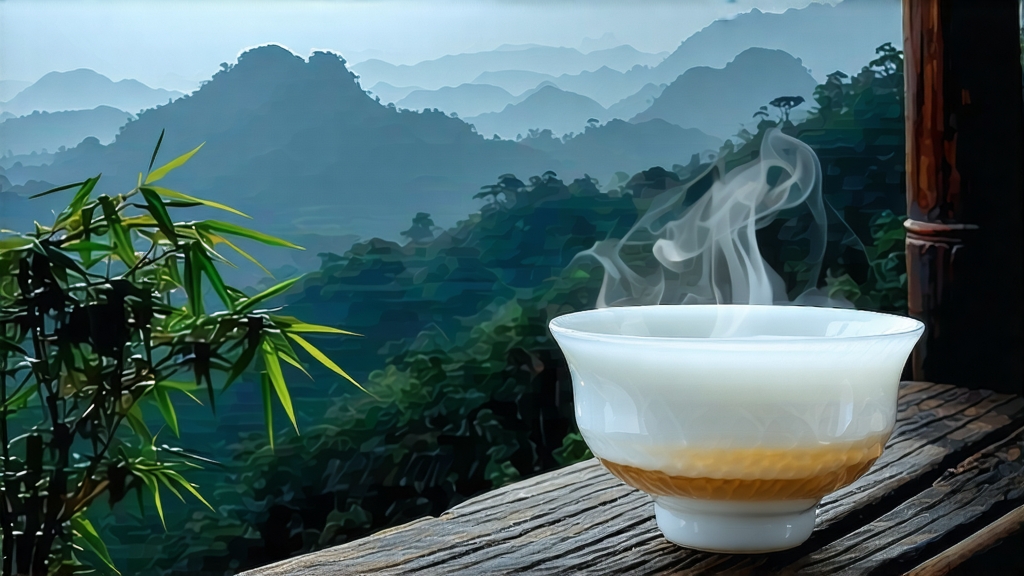
Tucked beneath the humid, fog-laced mountains of southern Guangxi, the small river town of Wuzhou guards a tea secret that once traveled the Silk Road’s southern corridor: Liupu dark tea. While Pu-erh commands global fame, Liupu—its quieter cousin—has been fermenting in bamboo baskets and river-bank storehouses since the Ming dynasty, developing a personality so distinct that locals simply call it “underground tea.” To international drinkers who equate darkness with heaviness, Liupu offers a surprise: a bright amber liquor, a betel-nut sweetness, and a finish that cools the throat like mint plucked from limestone cliffs.
Historical whispers place Liupu’s birth during the Jiajing era (1522–1566), when boatmen loaded rough green tea from Yunnan and Guangxi onto cargo rafts bound for Guangzhou and Hong Kong. River humidity soaked the leaf; bilge heat coaxed microbial life. By the time the rafts reached Wuzhou’s wharves, the tea had turned a dull ebony, its bitterness replaced by a mellow, medicinal sweetness. Merchants christened the tea after Liupu village, the last major anchorage before the Pearl River delta. For three centuries Liupu bricks moved southward, paying tribute to Portuguese traders, Malay tin miners, and the tea-cake pantries of Macanese households. When the Opium Wars rerouted commerce, Liupu retreated into domestic obscurity, aging quietly in communal cellars until the 1950s, when state tea corporations revived it as an export commodity for Southeast Asia, where its digestive reputation had never faded.
Today Liupu belongs to China’s National Geographic Indication list; only leaf picked within Wuzhou’s Xijiang basin and processed inside the city’s humid microclimate may bear the name. The tea is divided into two stylistic families: San Cha (loose leaf) and Zhuan Cha (brick). San Cha, the older style, ferments in cylindrical bamboo baskets called longtang; workers pile 60–70 kg of lightly wilted leaf, cover it with banana leaves, and slide the basket into a cellar whose walls weep with condensation. There the pile breathes at 28–32 °C for 35–50 days, turned every five days to coax an even bloom of Eurotium cristatum, the same golden “flower” spore prized in Hunan’s Fu brick. Zhuan Cha, codified in 1958, repeats the same piling but compresses the damp leaf into 1 kg rectangular bricks wrapped in reed leaves and stored in stacks six meters high, where gravity and humidity continue the fermentation for months. The result is a leaf the color of rusted iron, perfumed with camphor, dried longan, and the unmistakable note of betel quid—an echo of the areca nut once traded alongside it.
Craft begins in late April, when the first subtropical rains swell the tea bushes. Pluckers take one bud with the first three leaves, a standard that yields enough stem to feed the microbes yet enough tip to lend sweetness. The leaf is solar-wilted on bamboo trays for two hours, then wok-fired at 200 °C for eight minutes to arrest oxidation while preserving leaf enzymes. A short rolling—just enough to bruise the edges—precedes the pivotal “dui wo” (wet piling). Unlike Pu-erh’s 60–70 % moisture, Liupu uses a restrained 45 %, allowing slower, yeast-driven fermentation that foregrounds fruity esters over earthy bass notes. When the pile emits a ripe pineapple aroma and the leaf turns chestnut brown, it is sun-dried on riverine granite slabs, absorbing mineral notes from evaporating spray. For brick production, the leaf is steamed for 30 seconds, pressed under 20-ton hydraulic plates, then wrapped in reed leaves that imprint a grassy veining on the surface. The bricks enter “cave storage,” chambers dug into Wuzhou’s karst hills where humidity hovers at 85 % and temperature cycles between 20 °C at dawn and 30 °C at dusk. In this subterranean lung the tea respires for a minimum of one year; vintage lots of 15–30 years command prices rivaling aged Pu-erh.
To brew Liupu is to court contradiction: a tea born of dank cellars yet capable of lyrical clarity. Start with a 120 ml porcelain gaiwan; its neutral glaze showcases the liquor’s apricot